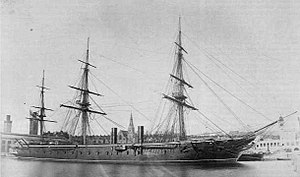 Warrior in the 1860s
| |
| Class overview | |
|---|---|
| Name | Warrior-class ironclad |
| Operators | |
| Preceded by | None |
| Succeeded by | Defence class |
| Built | 1859–1862 |
| In service | 1861–1979 |
| In commission | 1861–1902 |
| Completed | 2 |
| Scrapped | 1 |
| Preserved | 1 |
| General characteristics (Warrior as built) | |
| Type | Armoured frigate |
| Displacement | 9,137 long tons (9,284 t) |
| Length | 420 ft (128.0 m) |
| Beam | 58 ft 4 in (17.8 m) |
| Draught | 26 ft 10 in (8.2 m) |
| Installed power | 5,267 ihp (3,928 kW) |
| Propulsion | 1 shaft, 1 Trunk steam engine |
| Sail plan | Ship rig |
| Speed | 14 knots (26 km/h; 16 mph) |
| Range | 2,100 nmi (3,900 km; 2,400 mi) at 11 knots (20 km/h; 13 mph) |
| Complement | 707 |
| Armament |
|
| Armour | |
The Warrior-class ironclads were a class of two warships built for the Royal Navy between 1859 and 1862, the first ocean-going ironclads with iron hulls ever constructed. The ships were designed as armoured frigates in response to an invasion scare sparked by the launch of the French ironclad Gloire and her three sisters in 1858. They were initially armed with a mix of rifled breech-loading and muzzle-loading smoothbore guns, but the Armstrong breech-loading guns proved unreliable and were ultimately withdrawn from service.
The ships spent their first commission with the Channel Fleet before being rearmed with new rifled muzzle-loading guns in the late 1860s. Warrior rejoined the Channel Fleet after her refit while Black Prince joined the 1st Class Reserve and joined the fleet during its annual manoeuvres. The two ships exchanged roles after another refit in the mid-1870s. Both ships spent most of the last two decades of the 19th century in reserve. Warrior was hulked in 1902 and survived to be restored in 1979 as a museum ship. Black Prince became a training ship in 1896 and was hulked in 1910 before being sold for scrap in 1923.